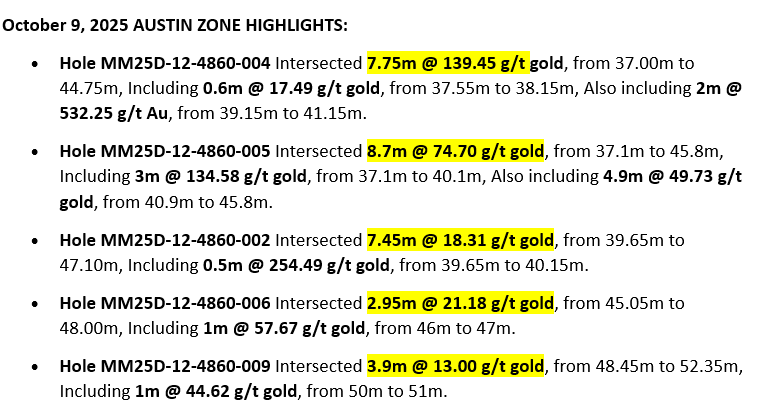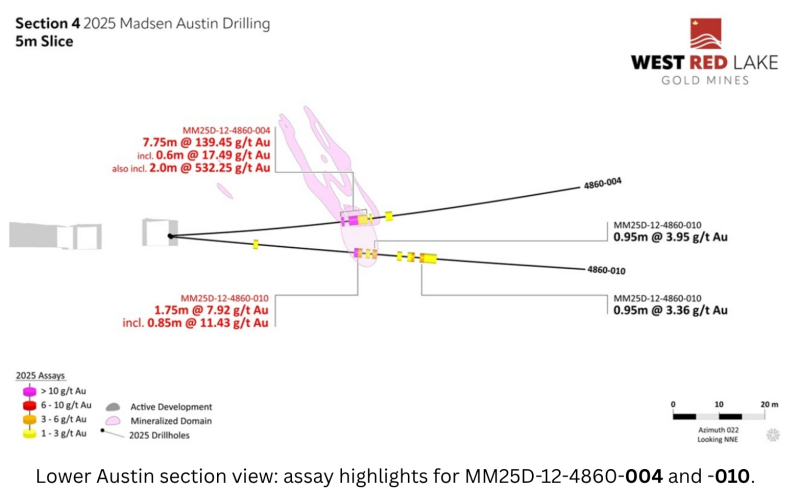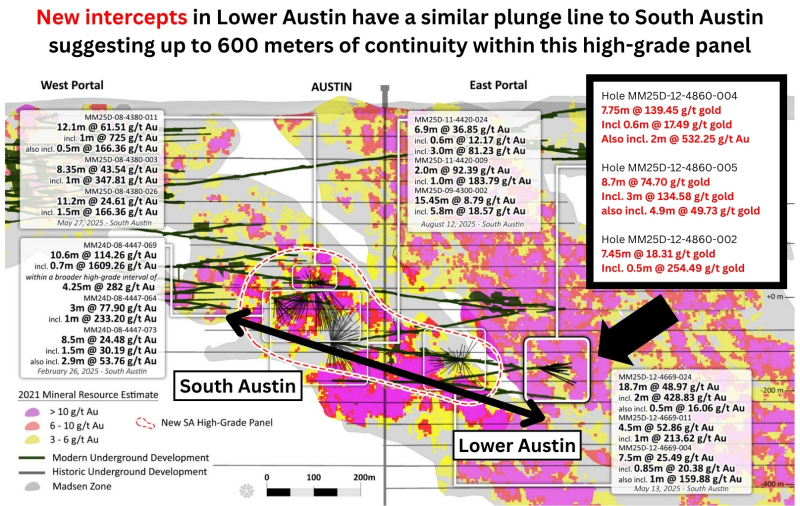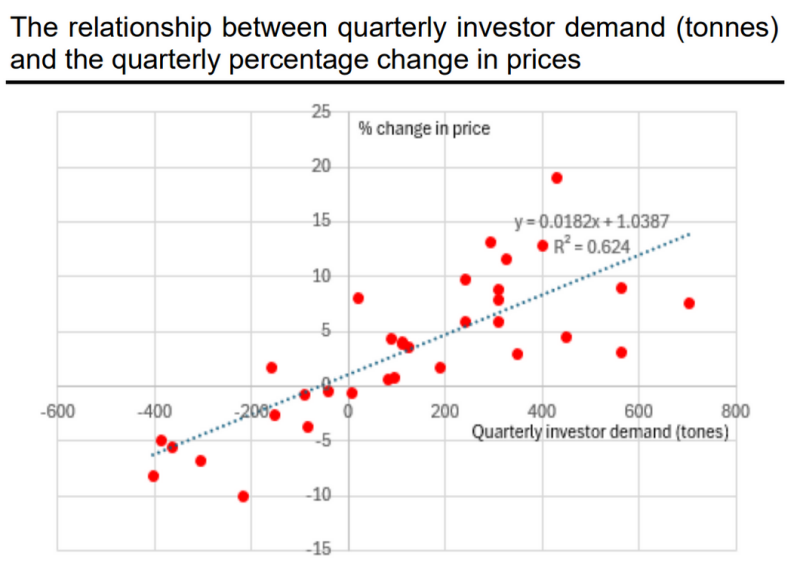 | |||||||||
 |  |  |  | ||||||
Vancouver, BC – TheNewswire - October 14, 2025 – Global Stocks News - Sponsored content disseminated on behalf of West Red Lake Gold. On October 9, 2025, West Red Lake Gold Mines (TSXV: WRLG) (OTCQB: WRLGF) reported high-grade drill results from the Lower Austin Zone, which currently contains an Indicated mineral resource of 914,200 ounces, grading 6.9 grams per tonne gold, with an additional Inferred resource of 104,900 ounces grading 6.5 g/t gold.
These results were drilled from the 12 Level in the Madsen Mine at approximately 600 meters depth and are from West Red Lake Gold’s first effort doing the tight-spaced drilling that delineates mineralization with high resolution ahead of mining in this deeper part of Austin. To immediately intersect such strong mineralization demonstrates the potential for discovery of additional high-grade lenses of gold mineralization in the main Austin Zone.
Located in Northwestern Ontario, Canada, West Red Lake Gold is currently focusing on three objectives: 1. Achieving targeted ramp-up gold ounce production, 2. Instituting new operational efficiencies and 3. Adding high-confidence gold ounces to the metal inventory.

“We are only just beginning to get the underground drills into the lower portions of the main Austin Zone, and we are already being rewarded with very high-grade, broad intercepts of gold mineralization – similar to the high-grade lenses we have been defining in South Austin,” stated Shane Williams, President & CEO.
“Our team is the first to get underground drills and mine crews back into these deeper parts of the orebody since this area was historically mined in the 1950’s and early 60’s. As expected, there is significant ounce and tonnage potential remaining at depth in the Madsen orebody.”
Red Lake is famous for high-grade narrow gold veins. Millions of years ago, when the molten gold came up through cracks in the rock, occasionally it would hit a softer area of rock. When this happened, instead of narrow veins, you get a pooling of metallic fluids.
Madsen currently has resources defined down to depths of over one kilometer. The Red Lake District is known for deep deposits that typically get thicker at lower depths. These deeper high-grade zones can radically change a company’s production profile.
For instance, Newmont Goldcorp/Evolution’s Red Lake Mine produced 58,875 ounces of gold @ 8.1 g/t in 1995. The next year they discovered a high-grade gold zone at 1,400 meters depth. By 2004, the Red Lake Mine was producing 552,000 ounces of gold @ 77.1 g/t.
The October 9, 2025 intersect of 7.75m @ 139.45 g/t gold was drilled from a station 600 meters below surface. WRLG believes there is a potential to expand gold resources with further exploration at depth.
In an October 9, 2025 YouTube video, West Red Lake Gold VP Communications, Gwen Preston, explained the significance of the latest Lower Austin drill results.
“The rocks of the Red Lake District of Ontario, which is where our Madsen mine is located, carry really high-grade gold,” said Preston in the video. “They've produced 30 million ounces over the last 100 years. But the mineralization is not evenly spread along the veins. It occurs in lenses, nuggets, pockets and pieces.”
“To manage that discontinuity, we drill Madsen at seven-meter spacing, before we mine the deposit. It takes that much data to model the deposit with accuracy and resolution. When you put that effort into these Red Lake deposits, they often repay you with phenomenal gold mineralization.”
Preston explained that the Red Lake Mine down the road from Madsen has been operating for 80 years. Their production has been fueled by pockets of rich mineralization known as “jewelry boxes”. WRLG discovered its first jewelry box in South Austin, which generated standout drill results in the first half of 2025. The company will be mining that area in the coming months.
“We just found our second jewelry box in the lower part of the Austin zone,” continued Preston. We had a lot of data on this deposit that suggested that it had good potential to host strong gold mineralization.”
“We're excited to keep getting deeper at Madsen, because we believe this deposit has a lot more to give,” said Preston. “That's the context for the October 9, 2025 batch of drill results. We've hit a new high-grade pocket at Madsen, deeper in the Austin zone. It feels like the kind of jewelry box that Red Lake deposits have been known to offer up to the teams that put in the work in this district.”
“It's a nice validation of why we're excited to be putting Madsen back into production,” concluded Preston in the explainer video. “For what we know we have, and for what we think we will still discover.”
“With gold already trading over $4,100 on Monday afternoon following last week’s unprecedented break above $4,000 per ounce,” wrote Kitco News on October 13, 2025. “Even a conservative projection of the yellow metal’s medium-term investment demand suggests the price could reach $5,000 per ounce by the end of next year, according to commodity analysts at Societe Generale (SocGen).”
“In the French banking giant’s latest commodity research report published Monday, analysts said that the gold price appears poised to gain another $1,000 in relatively short order”.
“Last week, gold prices reached $4,042/oz, just $276/oz below our bullish $4,318/oz Q426 forecast we published just one month ago,” wrote SocGen. “As of this morning, prices have risen to $4,072/oz. With ETF flows remaining strong, central bank buying expected to be resilient, we feel confident and compelled to update our target prices for gold.”
The mine plan in the Madsen Mine Pre-Feasibility Study (PFS) [1] used a gold price of US$1,680/ounce – about 40% of the current gold price of $4,100/ounce. This led to a mine plan with 60% of the mining being small, high-grade stopes requiring the use of cut-and-fill mining, which is selective and relatively high cost. [1] [2]
Using a higher gold price in stope design effectively lowers the cutoff grade for resource inclusion, producing more overall ounces. As the gold price rises, more of the gold-bearing rock becomes economically viable. WRLG does not have to be as selective. Larger stopes typically translate to an increase in tonnage and contained ounces, which leads to lower mining costs.
“We anticipate continued success in lower Austin as the drills continue to discover and define more lenses of high-grade mineralization adjacent to our active mine development,” stated Williams in the October 9, 2025 press release.
The technical information presented in this release has been reviewed and approved by Will Robinson, P.Geo., Vice President of Exploration for West Red Lake Gold and the Qualified Person for exploration at the West Red Lake Project, and by Maurice Mostert, P.Eng., Vice President of Technical Services Maurice for West Red Lake Gold and the Qualified Person for technical services at the West Red Lake Project, as defined by National Instrument 43-101 - Standards of Disclosure for Mineral Projects.
Contact: guy.bennett@globalstocksnews.com
Disclaimer: West Red Lake Gold paid Global Stocks News (GSN) $1,750 for the research, writing and dissemination of this content.
Full Disclaimer: GSN researches and fact-checks diligently, but we cannot ensure our publications are free from error. Investing in publicly traded stocks is speculative and carries a high degree of risk. GSN publications may contain forward-looking statements such as “project,” “anticipate,” “expect,” which are based on reasonable expectations, but these statements are imperfect predictors of future events. When compensation has been paid to GSN, the amount and nature of the compensation will be disclosed clearly.
References:
1. Please refer to the technical report entitled “NI 43-101 Technical Report and Prefeasibility Study for the Madsen Mine, Ontario, Canada”, prepared by SRK Consulting (Canada) Inc. and dated January 7, 2025. A full copy of the SRK report is available on the Company’s website and on SEDAR+ at www.sedarplus.ca.
2. See PFS Section 16.5.3 Mining Methods – Underground Mining Methods – Planned Mining Methods.
Additional References:
3. See PFS Report Section 21.3.2 Capital and Operating Costs – Operating Cost Estimates – Mining.
4. Mineral reserve estimates based on a gold price of US$1,680/oz and an exchange rate of 1.31 C$/US$. Longhole stope cut-off grade of 4.30 gpt Au based on an estimated operating cost of C$287.34/t including mining, plant and G&A. Mechanized Cut and Fill stope cut-off grade of 5.28 gpt Au based on an estimated operating cost of C$354.90/t including mining, plant and G&A. Incremental development cut-off grade of 1 gpt Au. A small amount of incremental longhole tonnes were included at a cut-off grade of not less than 3.4 gpt Au, these must be immediately adjacent to economic stopes that will pay for the capital to access area.
5. Mineral resources are estimated at a cut-off grade of 3.38 g/t Au and a gold price of US$1,800/oz. Mineral resources are not considered mineral reserves as they have not demonstrated economic viability.
6. See Section 24.1 Other Relevant Data – Gold Price Sensitivity.
Copyright (c) 2025 TheNewswire - All rights reserved.



